Satellite Observation of the Marine Light-Fishing and Its Dynamics in the South China Sea
Abstract
:1. Introduction
2. Material and Methods
2.1. Study Area
2.2. Dataset and Pre-Processing
- (1)
- VIIRS DNB data. This study mainly relied on the version 1 monthly cloud-free VIIRS DNB composites from April 2012 to April 2019 provided by the Earth Observations Group (https://www.ngdc.noaa.gov/eog/viirs/download_dnb_composites.html (last accessed on 3 May 2021)). The VIIRS DNB data used in the study were monthly average radiance composite products excluding the data impacted by stray light, lightning, lunar illumination and cloud-cover, spanning from 75° N to 65° S. Each dataset contains average radiance images and cloud-free coverage. The monthly average radiance data has two configurations designated as ‘vcm’ and ‘vcmsl’ respectively. The ‘vcmsl’ version has reduced quality after the stray-light correction and its application is biased toward the poles. Thus, we selected the ‘vcm’ version (stray light-impacted data were excluded) for further analysis.
- (2)
- Administrative division data. The administrative division data used in this study, such as the national boundaries, coastlines and the range of islands and reefs were downloaded from the global administrative division website (http://www.gadm.org/version2 (last accessed on 3 May 2021)) at a scale of 1:1,000,000.
- (3)
- Gridded bathymetric datasets. Gridded bathymetric data used in this study were collected from the British Oceanographic Data Centre (BODC, http://www.bodc.ac.uk/data/online_delivery/gebco/ (last accessed on 3 May 2021)), which build global terrain models for ocean and land with a spatial resolution of 30 arc-second.
- (4)
- Tropical storm dataset. Tropical storm tracking information were collected from the digital typhoon website (http://agora.ex.nii.ac.jp/digital-typhoon/ (last accessed on 3 May 2021)). It provides a series of information for each labeled Northwest Pacific tropical cyclone at a six-hour interval from April 2012 to April 2019. A total 2363 records of tropical storms (wind speed > 17.2 m/s) in the SCS were selected for this study, which contains a list of key parameters such as name, duration(h), location (latitude and longitude), maximum wind speed(m/s) and influence radius.
- (5)
- Volunteer Observation Ship (VOS) data. VOS records are provided by the National Climatic Data Center (https://www.ncdc.noaa.gov/data-access/marineocean-data/vosclim/data-management-and-access (last accessed on 3 May 2021)) for reporting up-to-date information about the ship location and weather. Most ships recorded in the database were merchant ships in the world’s sea lane.
2.3. Methodology
2.3.1. Pre-Processing
2.3.2. False Alarm Mask Factor Extraction
- (1)
- Coastal light source: The light emissions from the coastal city or their port such as socio-economic activity and infrastructure construction fell within 2 km of the land set were labeled as coastal or port light source. The land-sea mask surrounded by a 2 km buffer is a basic mask for subsequent process.
- (2)
- Island/reef light source: The scattered islets in the SCS are either equipped with numerous illuminant facilities such as airports and lighthouses or not available for fishing. The nighttime lights set fell within 2 km of the islets dataset were labeled as island/reef light source.
- (3)
- Offshore oil/gas platform light source: The SCS possesses abundant oil/gas resource stock and frequent exploitation. In the VIIRS images, gas flares have notably higher brightness than the others. The offshore oil/gas set was defined by the known database of natural gas flares (1074 confirmed offshore platforms) in the SCS surrounded by a one km buffer accounting for the halo effect of gas flares.
- (4)
- High-frequency light source: The non-zero pixels for other potential permanent sources (e.g., lights from other platforms, storage boats or others unknown) were masked out by using NTL time series. The high-frequency source extent is recognized as pixels in an accumulated binary image during 2012–2019 that possess an occurrence frequency higher than a user-defined threshold (30) due to the spatio-temporal variability of fishing activity. The binary images were determined by using an empirical threshold 0.5 nW cm−2 sr−1 to remove the non-light pixels or noise.
- (5)
- Non-stationary ship light source (Merchant ship): The presence of numerous merchant ships in the SCS, as a vital sea-lane through which one-third of world trade passes, has significant consequence in the process of fishing vessels detection. All pixels for merchant ship lights were masked out by using the VOS-based mask. The VOS-based trajectory clustering analysis [79], including centerline of channel and trajectory extraction, was adopted to extract the merchant ship source mask.
2.3.3. Detection Algorithms
- (1)
- Illumination Edge Detection
- (2)
- Candidate Detection
- (3)
- Threshold Detection
- (4)
- Masking and Vectorization
2.3.4. Time Series Analysis
3. Results
3.1. Spatial Analysis of Nighttime Fishing Lights in the SCS
3.1.1. Distribution of Night-Time Fishing Lights in the SCS
3.1.2. Spatial Getis-Ord Statistical Analysis
3.2. Temporal Series Analysis of Nighttime Fishing Activity
3.2.1. Time Frequency Analysis from HHT Transformation
3.2.2. Temporal Analysis of Nighttime Fishing Light for Subregions
3.2.3. Temporal Analysis of Nighttime Fishing Intensity
4. Discussion
4.1. Impact of Cloud-Coverage
4.2. Correlation Relationship between the TOL and the Number of Nighttime Fishing Light
4.3. The Impacts of Tropical Storms on the Nighttime Fishing Activity
5. Conclusions
Supplementary Materials
Author Contributions
Funding
Institutional Review Board Statement
Informed Consent Statement
Data Availability Statement
Acknowledgments
Conflicts of Interest
References
- McManus, J.W.; Shao, K.-T.; Lin, S.-Y. Toward establishing a Spratly Islands international marine peace park: Ecological importance and supportive collaborative activities with an emphasis on the role of Taiwan. Ocean. Dev. Int. Law 2010, 41, 270–280. [Google Scholar] [CrossRef]
- Paterson, C.J.; Pernetta, J.C.; Siraraksophon, S.; Kato, Y.; Barut, N.C.; Saikliang, P.; Vibol, O.; Chee, P.E.; Nguyen, T.T.N.; Perbowo, N.; et al. Fisheries refugia: A novel approach to integrating fisheries and habitat management in the context of small-scale fishing pressure. Ocean Coast. Manag. 2013, 85, 214–229. [Google Scholar] [CrossRef]
- Silvestre, G.; Garces, L.R.; Stobutzki, I.; Ahmed, M.; Valmonte-Santos, R.A.; Luna, C.Z.; Zhou, W. South and South-East Asian Coastal Fisheries: Their Status and Directions for Improved Management: Conference Synopsis and Recommendations. In WorldFish Center Conference Proceedings of Assessment, Management and Future Directions for Coastal Fisheries in Asian Countries, Penang, Malaysia; 2003; Volume 67, pp. 1–40. [Google Scholar]
- Teh, L.S.L.; Witter, A.; Cheung, W.W.L.; Sumaila, U.R.; Yin, X. What is at stake? Status and threats to South China Sea marine fisheries. Ambio 2017, 46, 57–72. [Google Scholar] [CrossRef] [PubMed] [Green Version]
- Zhang, J.; Zhang, K.; Chen, Z.; Dong, J.; Qiu, Y. Hydroacoustic studies on Katsuwonus pelamis and juvenile Thunnus albacares associated with light fish-aggregating devices in the South China Sea. Fish Res. 2021, 233, 105765. [Google Scholar] [CrossRef]
- Xu, L.; Wang, X.; Van Damme, K.; Huang, D.; Li, Y.; Wang, L.; Ning, J.; Du, F. Assessment of fish diversity in the South China Sea using DNA taxonomy. Fish Res. 2021, 233, 105771. [Google Scholar] [CrossRef]
- La Torre, G.L.; Cicero, N.; Bartolomeo, G.; Rando, R.; Vadalà, R.; Santini, A.; Durazzo, A.; Lucarini, M.; Dugo, G.; Salvo, A. Assessment and monitoring of fish quality from a coastal ecosystem under high anthropic pressure: A case study in southern Italy. Int. J. Environ. Res. Public Health 2020, 17, 3285. [Google Scholar] [CrossRef] [PubMed]
- Thang, N.D. Fisheries cooperation in the South China Sea and the (Ir)relevance of the sovereignty question. Asian J. Int. Law 2011, 2, 59. [Google Scholar] [CrossRef]
- Hal, R.; Griffioen, A.B.; Keeken, O.A. Changes in fish communities on a small spatial scale, an effect of increased habitat complexity by an offshore wind farm. Mar. Environ. Res. 2017, 126, 26–36. [Google Scholar] [CrossRef]
- Guan, W.; Gao, F.; Chen, X. Review of the applications of satellite remote sensing in the exploitation, management and protection of marine fisheries resources. J. Shanghai Ocean Univ. 2017, 26, 440–449. [Google Scholar] [CrossRef]
- Yu, W.; Chen, X.; Yi, Q.; Chen, Y. Spatio-temporal distributions and habitat hotspots of the winter–spring cohort of neon flying squid Ommastrephes bartramii in relation to oceanographic conditions in the Northwest Pacific Ocean. Fish Res. 2016, 175, 103–115. [Google Scholar] [CrossRef]
- Paulino, C.; Segura, M.; Chacón, G. Spatial variability of jumbo flying squid (Dosidicus gigas) fishery related to remotely sensed SST and chlorophyll-a concentration (2004–2012). Fish Res. 2016, 173, 122–127. [Google Scholar] [CrossRef]
- Solanki, H.U.; Bhatpuria, D.; Chauhan, P. Signature analysis of satellite derived SSHa, SST and chlorophyll concentration and their linkage with marine fishery resources. J. Mar. Syst. 2015, 150, 12–21. [Google Scholar] [CrossRef]
- Yasuda, T.; Ohshimo, S.; Yukami, R. Fishing ground hotspots reveal long-term variation in chub mackerel Scomber japonicus habitat in the East China Sea. Mar. Ecol. Prog. Ser. 2014, 501, 239–250. [Google Scholar] [CrossRef] [Green Version]
- Wang, W.; Zhou, C.; Shao, Q.; Mulla, D. Remote sensing of sea surface temperature and chlorophyll-a: Implications for squid fisheries in the north-west Pacific Ocean. Int. J. Remote Sens. 2010, 31, 4515–4530. [Google Scholar] [CrossRef]
- Kumari, B.; Raman, M. Whale shark habitat assessments in the northeastern Arabian Sea using satellite remote sensing. Int. J. Remote Sens. 2010, 31, 379–389. [Google Scholar] [CrossRef]
- Gauthier-Ouellet, M.; Dionne, M.; Ois, F.; King, T.; Bernatchez, L. Spatiotemporal dynamics of the Atlantic salmon (Salmo salar) Greenland fishery inferred from mixed-stock analysis. Can. J. Fish. Aquat. Sci. 2009, 66, 2040–2051. [Google Scholar] [CrossRef] [Green Version]
- Leeney, R.; Amies, R.; Broderick, A.; Witt, M.; Loveridge, J.; Doyle, J.; Godley, B. Spatio-temporal analysis of cetacean strandings and bycatch in a UK fisheries hotspot. Biodivers. Conserv. 2008, 17, 2323–2338. [Google Scholar] [CrossRef]
- Su, F.; Zhang, J.; Du, Y.; Zhou, C.; Shao, Q. Spatiotemporal variations of pelagic fishery resources in East China Sea. J. Nat. Resour. 2004, 19, 591–596. [Google Scholar] [CrossRef]
- Zhang, H.; Yang, S.-L.; Fan, W.; Shi, H.-M.; Yuan, S.-L. Spatial analysis of the fishing behaviour of Tuna Purse Seiners in the western and central Pacific based on vessel trajectory data. J. Mar. Sci. Eng. 2021, 9, 322. [Google Scholar] [CrossRef]
- Lin, Y.; Yu, X.; Huang, L.; Sanganyado, E.; Bi, R.; Li, P.; Liu, W. Risk assessment of potentially toxic elements accumulated in fish to Indo-Pacific humpback dolphins in the South China Sea. Sci. Total Environ. 2021, 761, 143256. [Google Scholar] [CrossRef]
- Zhang, K.; Guo, J.; Xu, Y.; Jiang, Y.; Fan, J.; Xu, S.; Chen, Z. Long-term variations in fish community structure under multiple stressors in a semi-closed marine ecosystem in the South China Sea. Sci. Total Environ. 2020, 745, 140892. [Google Scholar] [CrossRef] [PubMed]
- Wang, Y.; Yao, L.; Chen, P.; Yu, J.; Wu, Q.E. Environmental influence on the spatiotemporal variability of fishing grounds in the Beibu Gulf, South China Sea. J. Mar. Sci. Eng. 2020, 8, 957. [Google Scholar] [CrossRef]
- Zhang, M.; Wu, Y.; Qi, L.J.; Xu, M.Q.; Yang, C.H.; Wang, X.L. Impact of the migration behavior of mesopelagic fishes on the compositions of dissolved and particulate organic carbon on the northern slope of the South China Sea. Deep-Sea Res. Part II-Top. Stud. Oceanogr. 2019, 167, 46–54. [Google Scholar] [CrossRef]
- Wei, P.; Wang, X.; Ma, S.; Zhou, Y.; Huang, Y.; Su, Y.; Wu, Q.E. Analysis of current status of marine fishing in South China Sea. J. Shanghai Ocean Univ. 2019, 28, 976–982. [Google Scholar] [CrossRef]
- Wang, X.H.; Qiu, Y.S.; Du, F.Y.; Liu, W.D.; Sun, D.R.; Chen, X.; Yuan, W.W.; Chen, Y. Roles of fishing and climate change in long-term fish species succession and population dynamics in the outer Beibu Gulf, South China Sea. Acta Oceanol. Sin. 2019, 38, 1–8. [Google Scholar] [CrossRef]
- Su, L.; Chen, Z.; Zhang, P.; Li, J.; Wang, H.; Huang, J. Catch composition and spatial-temporal distribution of catch rate of light falling-net fishing in central and southern South China Sea fishing ground in 2017. South China Fish. Sci. 2018, 14, 11–20. [Google Scholar] [CrossRef]
- Chen, L.C.; Lan, K.W.; Chang, Y.; Chen, W.Y. Summer assemblages and biodiversity of larval fish associated with hydrography in the northern South China Sea. Mar. Coast. Fish. 2018, 10, 467–480. [Google Scholar] [CrossRef] [Green Version]
- Fan, J.; Chen, G.; Chen, Z. Forecasting fishing ground of calamary in the northern South China Sea according to habitat suitability index. South China Fish. Sci. 2017, 13, 11–16. [Google Scholar] [CrossRef]
- Asanuma, I.; Yamaguchi, T.; Park, J.; Mackin, K.; Mittleman, J. Detection of temporal change of fishery and island activities by DNB and SAR on the South China Sea. World Acad. Sci. Eng. Technol. Int. J. Comput. Electr. Autom. Control. Inf. Eng. 2017, 11, 252–255. [Google Scholar]
- Zheng, T.; Tang, Y. Analysis of current status of Chinese marine fishing fleet of South China Sea area. J. Shanghai Ocean Univ. 2016, 25, 620–627. [Google Scholar] [CrossRef]
- Zhang, L.; Li, Y.; Lin, L.; Yao, Z.; Yan, L.; Zhang, P. Fishery resources acoustic assessment of major economic species in south-central of the South China Sea. Mar. Fish. 2016, 38, 577–587. [Google Scholar] [CrossRef]
- Zhang, J.; Yao, Z.; Lin, L.; Li, Y.; Song, P.; Zhang, R.; Gao, T. Spatial distribution of biomass and fishery biology of main commercial fish in the mouth of Beibu bay and the southwestern waters of the Nansha Islands. Period. Ocean Univ. China 2016, 46, 158–167. [Google Scholar]
- Ji, S.; Zhou, W.; Wang, L.; Tang, F.; Wu, Z.; Chen, G. Relationship between temporal-spatial distribution of yellowfin tuna (Thunnus albacares) fishing grounds and sea surface temperature in the South China Sea and adjacent waters. Mar. Fish. 2016, 38, 9–16. [Google Scholar] [CrossRef]
- Yan, L.; Zhang, P.; Yang, L.; Yang, B.; Tan, Y.; Chen, S. A study of sinking characteristics of light falling-net fishing in the South China Sea. J. Shanghai Ocean Univ. 2014, 23, 146–153. [Google Scholar]
- Zhang, P.; Zeng, X.; Yang, L.; Peng, C.; Zhang, X.; Yang, S.; Tan, Y.; Yang, B.; Yan, L. Analyses on fishing ground and catch composition of large-scale light falling-net fisheries in South China Sea. South China Fish. Sci. 2013, 9, 74–79. [Google Scholar]
- Daqamseh, S.T.; Mansor, S.; Pradhan, B.; Billa, L.; Mahmud, A.R. Potential fish habitat mapping using MODIS-derived sea surface salinity, temperature and chlorophyll-a data: South China Sea Coastal areas, Malaysia. Geocarto Int. 2013, 28, 546–560. [Google Scholar] [CrossRef]
- Wang, X.; Qiu, Y.; Du, F.; Lin, Z.; Sun, D.; Huang, S. Dynamics of demersal fish species diversity and biomass of dominant species in autumn in the Beibu Gulf, northwestern South China Sea. Acta Ecol. Sin. 2012, 32, 333–342. [Google Scholar] [CrossRef] [Green Version]
- Chen, G.; Li, Y.; Chen, P.; Zhang, J.; Fang, L.; Li, N. Measurement of single-fish target strength in the South China Sea. Chin. J. Oceanol. Limnol. 2012, 30, 554–562. [Google Scholar] [CrossRef]
- Guiet, J.; Galbraith, E.; Kroodsma, D.; Worm, B. Seasonal variability in global industrial fishing effort. PLoS ONE 2019, 14, e0216819. [Google Scholar] [CrossRef] [PubMed]
- Kroodsma, D.A.; Mayorga, J.; Hochberg, T.; Miller, N.A.; Boerder, K.; Ferretti, F.; Wilson, A.; Bergman, B.; White, T.D.; Block, B.A. Tracking the global footprint of fisheries. Science 2018, 359, 904–908. [Google Scholar] [CrossRef] [PubMed] [Green Version]
- Bharti, N.; Tatem, A.J.; Ferrari, M.J.; Grais, R.F.; Djibo, A.; Grenfell, B.T. Explaining seasonal fluctuations of measles in Niger using nighttime lights imagery. Science 2011, 334, 1424–1427. [Google Scholar] [CrossRef] [Green Version]
- Cao, X.; Chen, J.; Imura, H.; Higashi, O. A SVM-based method to extract urban areas from DMSP-OLS and SPOT VGT data. Remote Sens. Environ. 2009, 113, 2205–2209. [Google Scholar] [CrossRef]
- Croft, T.A. The Brightness of Lights on Earth at Night, Digitally Recorded by DMSP Satellite; U.S. Geological Survey: Reston, VA, USA, 1979; p. 66. [Google Scholar]
- Dwyer, R.G.; Bearhop, S.; Campbell, H.A.; Bryant, D.M. Shedding light on light: Benefits of anthropogenic illumination to a nocturnally foraging shorebird. J. Anim. Ecol. 2013, 82, 478–485. [Google Scholar] [CrossRef] [PubMed]
- Elvidge, C.; Ziskin, D.; Baugh, K.; Tuttle, B.; Ghosh, T.; Pack, D.; Erwin, E.; Zhizhin, M. A fifteen year record of global natural gas flaring derived from satellite data. Energies 2009, 2, 595–622. [Google Scholar] [CrossRef]
- Elvidge, C.D.; Baugh, K.E.; Kihn, E.A.; Kroehl, H.W.; Davis, E.R.; Davis, C.W. Relation between satellite observed visible-near infrared emissions, population, economic activity and electric power consumption. Int. J. Remote Sens. 1997, 18, 1373–1379. [Google Scholar] [CrossRef]
- Imhoff, M.L.; Lawrence, W.T.; Elvidge, C.D.; Paul, T.; Levine, E.; Privalsky, M.V.; Brown, V. Using nighttime DMSP/OLS images of city lights to estimate the impact of urban land use on soil resources in the United States. Remote Sens. Environ. 1997, 59, 105–117. [Google Scholar] [CrossRef]
- Kuechly, H.U.; Kyba, C.C.; Ruhtz, T.; Lindemann, C.; Wolter, C.; Fischer, J.; Hölker, F. Aerial survey and spatial analysis of sources of light pollution in Berlin, Germany. Remote Sens. Environ. 2012, 126, 39–50. [Google Scholar] [CrossRef]
- Ma, T.; Zhou, Y.; Zhou, C.; Haynie, S.; Pei, T.; Xu, T. Night-time light derived estimation of spatio-temporal characteristics of urbanization dynamics using DMSP/OLS satellite data. Remote Sens. Environ. 2015, 158, 453–464. [Google Scholar] [CrossRef]
- Mazor, T.; Levin, N.; Possingham, H.P.; Levy, Y.; Rocchini, D.; Richardson, A.J.; Kark, S. Can satellite-based night lights be used for conservation? The case of nesting sea turtles in the Mediterranean. Biol. Conserv. 2013, 159, 63–72. [Google Scholar] [CrossRef] [Green Version]
- Rodrigues, P.; Aubrecht, C.; Gil, A.; Longcore, T.; Elvidge, C. Remote sensing to map influence of light pollution on Cory’s shearwater in São Miguel Island, Azores Archipelago. Eur. J. Wildl. Res. 2012, 58, 147–155. [Google Scholar] [CrossRef]
- Small, C.; Pozzi, F.; Elvidge, C.D. Spatial analysis of global urban extent from DMSP-OLS night lights. Remote Sens. Environ. 2005, 96, 277–291. [Google Scholar] [CrossRef]
- Waluda, C.; Yamashiro, C.; Elvidge, C.; Hobson, V.; Rodhouse, P. Quantifying light-fishing for Dosidicus gigas in the eastern Pacific using satellite remote sensing. Remote Sens. Environ. 2004, 91, 129–133. [Google Scholar] [CrossRef]
- Yi, K.; Tani, H.; Li, Q.; Zhang, J.; Guo, M.; Bao, Y.; Wang, X.; Li, J. Mapping and evaluating the urbanization process in northeast China using DMSP/OLS nighttime light data. Sensors 2014, 14, 3207–3226. [Google Scholar] [CrossRef] [PubMed] [Green Version]
- Zhang, Q.; Seto, K.C. Mapping urbanization dynamics at regional and global scales using multi-temporal DMSP/OLS nighttime light data. Remote Sens. Environ. 2011, 115, 2320–2329. [Google Scholar] [CrossRef]
- Yu, B.; Deng, S.; Liu, G.; Yang, C.; Chen, Z.; Hill, C.J.; Wu, J. Nighttime light images reveal spatial-temporal dynamics of global anthropogenic resources accumulation above ground. Environ. Sci. Technol. 2018, 52, 11520–11527. [Google Scholar] [CrossRef] [PubMed] [Green Version]
- Li, D.; Li, X. An overview on data mining of nighttime light remote sensing. Acta Geod. Cartogr. Sin. 2015, 44, 591–601. [Google Scholar] [CrossRef]
- Levin, N.; Kyba, C.C.M.; Zhang, Q.; Sánchez de Miguel, A.; Román, M.O.; Li, X.; Portnov, B.A.; Molthan, A.L.; Jechow, A.; Miller, S.D.; et al. Remote sensing of night lights: A review and an outlook for the future. Remote Sens. Environ. 2020, 237, 111443. [Google Scholar] [CrossRef]
- Xu, Z.; Xu, Y. Study on the spatio-temporal evolution of the Yangtze River Delta urban agglomerationby integrating DMSP/OLS and NPP/VIIRS Nighttime Light Data. J. Geo-Inf. Sci. 2021, 23, 837–849. [Google Scholar] [CrossRef]
- Waluda, C.M.; Griffiths, H.J.; Rodhouse, P.G. Remotely sensed spatial dynamics of the Illex argentinus fishery, Southwest Atlantic. Fish Res. 2008, 91, 196–202. [Google Scholar] [CrossRef]
- Kiyofuji, H.; Saitoh, S.-I. Use of nighttime visible images to detect Japanese common squid Todarodes pacificus fishing areas and potential migration routes in the Sea of Japan. Mar. Ecol.-Prog. Ser. 2004, 276, 173–186. [Google Scholar] [CrossRef]
- Cho, K.; Ito, R.; Shimoda, H.; Sakata, T. Technical note and cover fishing fleet lights and sea surface temperature distribution observed by DMSP/OLS sensor. Int. J. Remote Sens. 1999, 20, 3–9. [Google Scholar] [CrossRef]
- Elvidge, C.D.; Baugh, K.E.; Zhizhin, M.; Hsu, F.-C. Why VIIRS data are superior to DMSP for mapping nighttime lights. Proc. Asia-Pac. Adv. Netw. 2013, 35, 62–69. [Google Scholar] [CrossRef] [Green Version]
- Liang, C.K.; Mills, S.; Hauss, B.I.; Miller, S.D. Improved VIIRS day/night band imagery with near-constant contrast. IEEE Trans. Geosci. Remote Sens. 2014, 52, 6964–6971. [Google Scholar] [CrossRef]
- Miller, S.D.; Turner, R.E. A dynamic lunar spectral irradiance data set for NPOESS/VIIRS day/night band nighttime environmental applications. IEEE Trans. Geosci. Remote Sens. 2009, 47, 2316–2329. [Google Scholar] [CrossRef]
- Li, X.; Ma, R.; Zhang, Q.; Li, D.; Liu, S.; He, T.; Zhao, L. Anisotropic characteristic of artificial light at night—Systematic investigation with VIIRS DNB multi-temporal observations. Remote Sens. Environ. 2019, 233, 111357. [Google Scholar] [CrossRef]
- Straka, W.; Seaman, C.; Baugh, K.; Cole, K.; Stevens, E.; Miller, S. Utilization of the suomi national polar-orbiting partnership (NPP) visible infrared imaging radiometer suite (VIIRS) day/night band for arctic ship tracking and fisheries management. Remote Sens. 2015, 7, 971–989. [Google Scholar] [CrossRef] [Green Version]
- Kyba, C.; Garz, S.; Kuechly, H.; de Miguel, A.; Zamorano, J.; Fischer, J.; Hölker, F. High-resolution imagery of earth at night: New sources, opportunities and challenges. Remote Sens. 2015, 7, 1–23. [Google Scholar] [CrossRef] [Green Version]
- Liu, Y.; Saitoh, S.-I.; Hirawake, T. Detection of squid and pacific saury fishing vessels around Japan using VIIRS day/night band image. Proc. Asia-Pac. Adv. Netw. 2015, 39, 28–39. [Google Scholar] [CrossRef]
- Zhang, X.; Saitoh, S.-I.; Hirawake, T.; Nakada, S.; Koyamada, K.; Awaji, T.; Ishikawa, Y.; Igarashi, H. An Attempt of Dissemination of Potential Fishing Zones Prediction Map of Japanese Common Squid in the Coastal Water, Southwestern Hokkaido, Japan. In Proceedings of the Asia-Pacific Advanced Network, A-Ju Art Gallery, Daejeon, Korea, 20–21 August 2013; pp. 132–141. [Google Scholar]
- Elvidge, C.; Zhizhin, M.; Baugh, K.; Hsu, F.-C. Automatic boat identification system for VIIRS low light imaging data. Remote Sens. 2015, 7, 3020–3036. [Google Scholar] [CrossRef] [Green Version]
- Cozzolino, E.; Lasta, C.A. Use of VIIRS DNB satellite images to detect jigger ships involved in the Illex argentinus fishery. Remote Sens. Appl. Soc. Environ. 2016, 4, 167–178. [Google Scholar] [CrossRef]
- Lebona, B.; Kleynhans, W.; Celik, T.; Mdakane, L. Ship Detection Using VIIRS Sensor Specific Data. In Proceedings of the IEEE International Geoscience and Remote Sensing Symposium (IGARSS), Beijing, China, 10–15 July 2016; pp. 1245–1247. [Google Scholar]
- Yamaguchi, T.; Asanuma, I.; Park, J.G.; Mackin, K.J.; Mittleman, J. Estimation of Vessel Traffic Density from Suomi NPP VIIRS Day/Night Band. In Proceedings of the Oceans Mts/Ieee Monterey, Monterey, CA, USA, 19–23 September 2016; pp. 1–5. [Google Scholar]
- Morton, B.; Blackmore, G. South China Sea. Mar. Pollut. Bull. 2001, 42, 1236–1263. [Google Scholar] [CrossRef]
- Liu, Z.F.; Zhao, Y.L.; Colin, C.; Stattegger, K.; Wiesner, M.G.; Huh, C.A.; Zhang, Y.W.; Li, X.J.; Sompongchaiyakul, P.; You, C.F.; et al. Source-to-sink transport processes of fluvial sediments in the South China Sea. Earth-Sci. Rev. 2016, 153, 238–273. [Google Scholar] [CrossRef]
- Alford, M.H.; Peacock, T.; MacKinnon, J.A.; Nash, J.D.; Buijsman, M.C.; Centurioni, L.R.; Chao, S.-Y.; Chang, M.-H.; Farmer, D.M.; Fringer, O.B.J.N. The formation and fate of internal waves in the South China Sea. Nature 2015, 521, 65–69. [Google Scholar] [CrossRef] [PubMed]
- Wang, J.; Li, M.; Liu, Y.; Zhang, H.; Zou, W.; Cheng, L. Safety assessment of shipping routes in the South China Sea based on the fuzzy analytic hierarchy process. Saf. Sci. 2014, 62, 46–57. [Google Scholar] [CrossRef]
- Sezgin, M.; Sankur, B. Survey over image thresholding techniques and quantitative performance evaluation. J. Electron. Imaging 2004, 13, 146–168. [Google Scholar] [CrossRef]
- Cao, C.; Bai, Y. Quantitative analysis of VIIRS DNB nightlight point source for light power estimation and stability monitoring. Remote Sens. 2014, 6, 11915–11935. [Google Scholar] [CrossRef] [Green Version]
- Canny, J. A computational approach to edge detection. IEEE Trans. Pattern Anal. Mach. Intell. 1986, 8, 679–698. [Google Scholar] [CrossRef]
- Wu, Z.; Huang, N.E.; Long, S.R.; Peng, C. On the trend, detrending, and variability of nonlinear and nonstationary time series. Proc. Natl. Acad. Sci. USA 2007, 104, 14889–14894. [Google Scholar] [CrossRef] [Green Version]
- Kong, Y.; Meng, Y.; Li, W.; Yue, A.; Yuan, Y. Satellite image time series decomposition based on EEMD. Remote Sens. 2015, 7, 15583–15604. [Google Scholar] [CrossRef] [Green Version]
- Wu, Z.; Huang, N.E. Ensemble empirical mode decomposition: A noise-assisted data analysis method. Adv. Adapt. Data Anal. 2009, 1, 1–41. [Google Scholar] [CrossRef]
- Xia, Z.; Li, D.; Li, X.; Zhao, L.; Wu, C. Spatial and seasonal patterns of night-time lights in global ocean derived from VIIRS DNB images. Int. J. Remote Sens. 2018, 39, 8151–8181. [Google Scholar] [CrossRef]
- Sun, C.; Liu, Y.; Li, M.; Chen, Z.; Zhao, S. An analysis of tropical storms impact on islands and reefs in the South China Sea in the past 35 years. Remote Sens. Land Resour. 2014, 26, 135–140. [Google Scholar] [CrossRef]
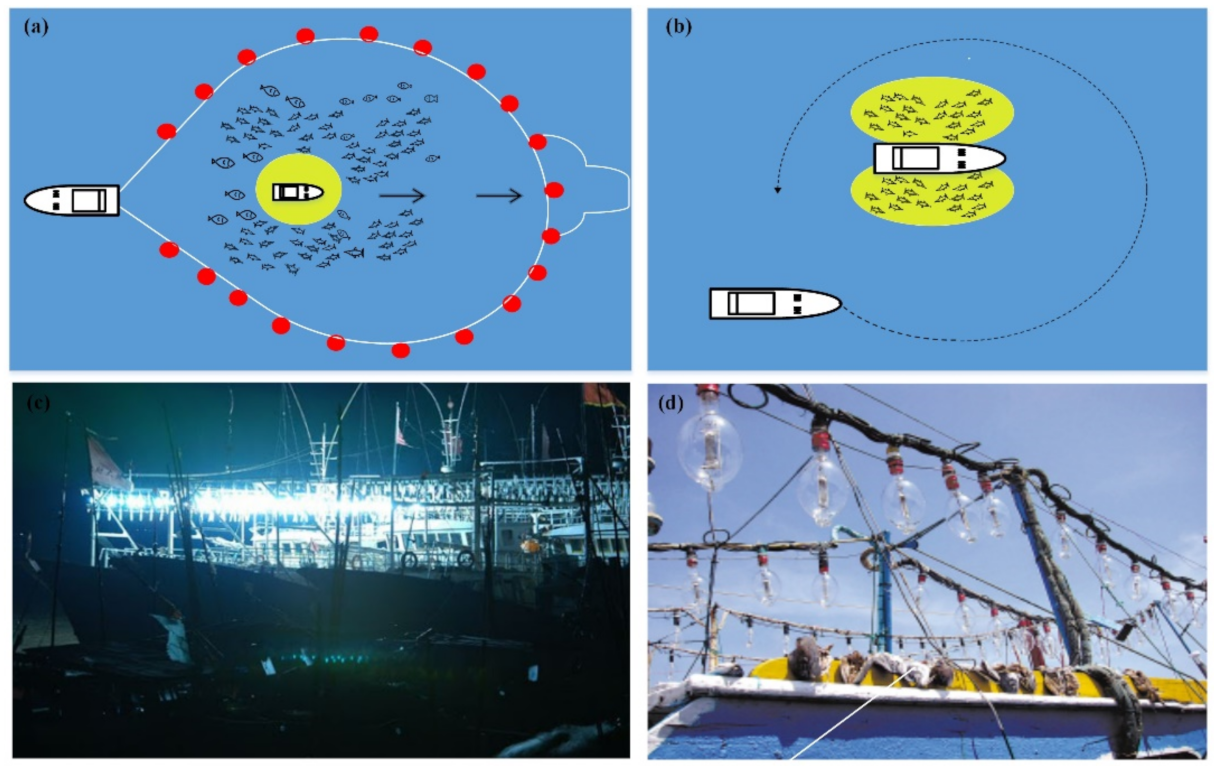
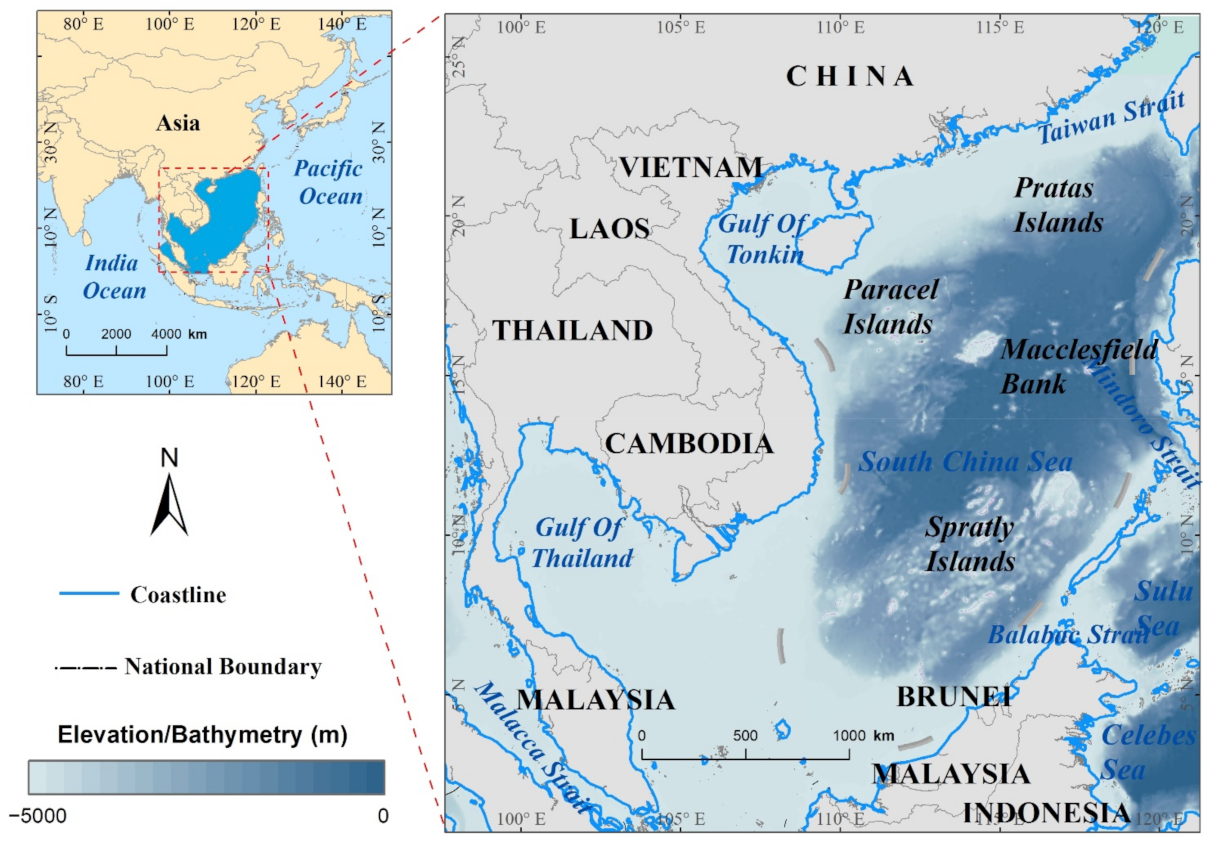

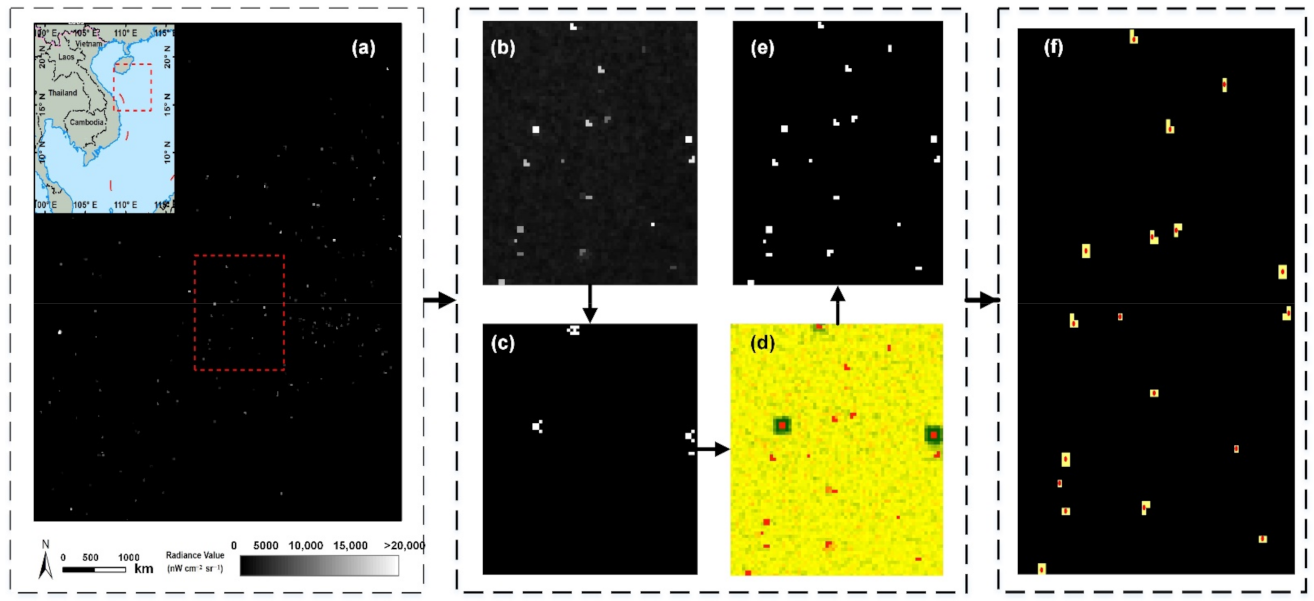

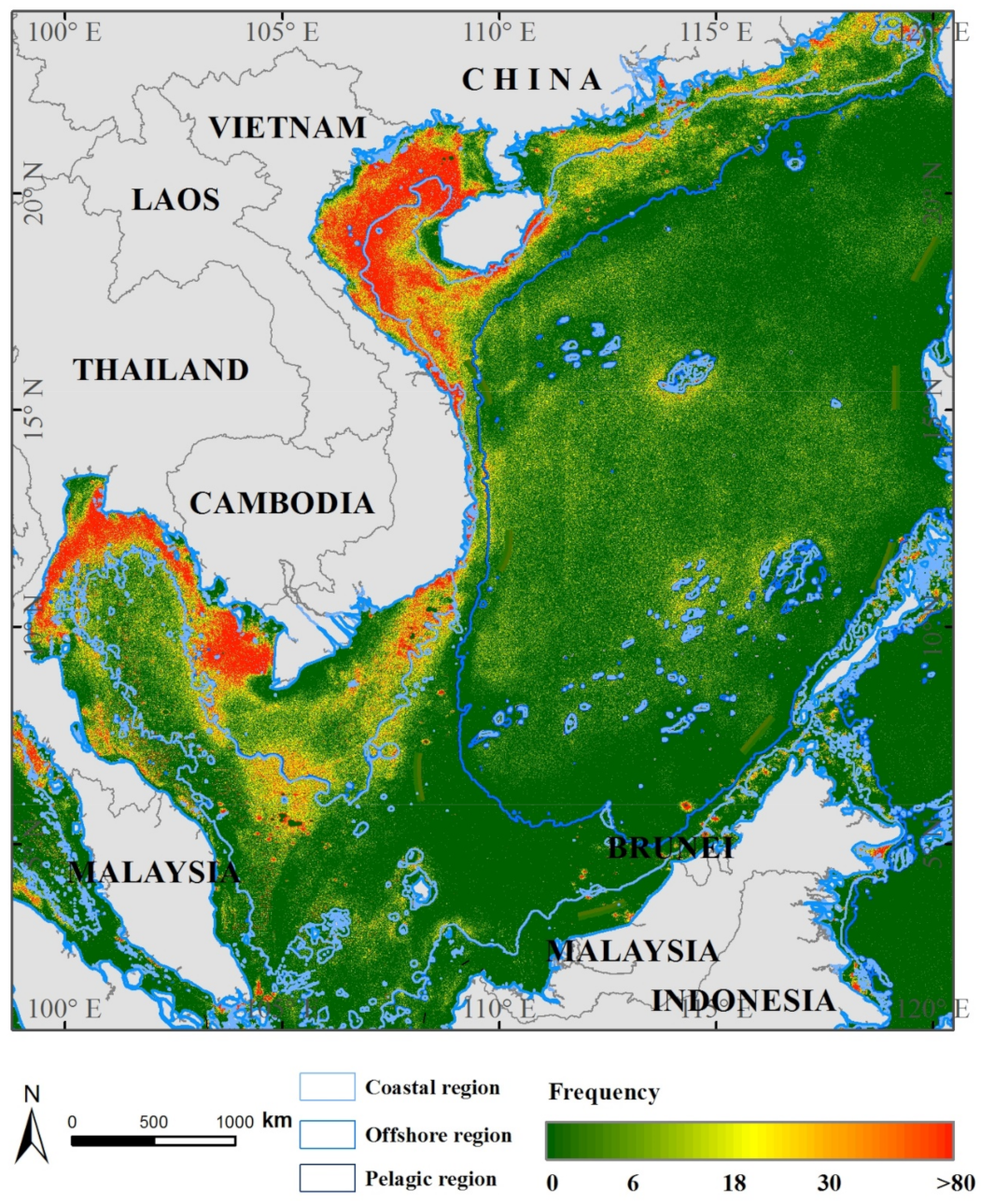
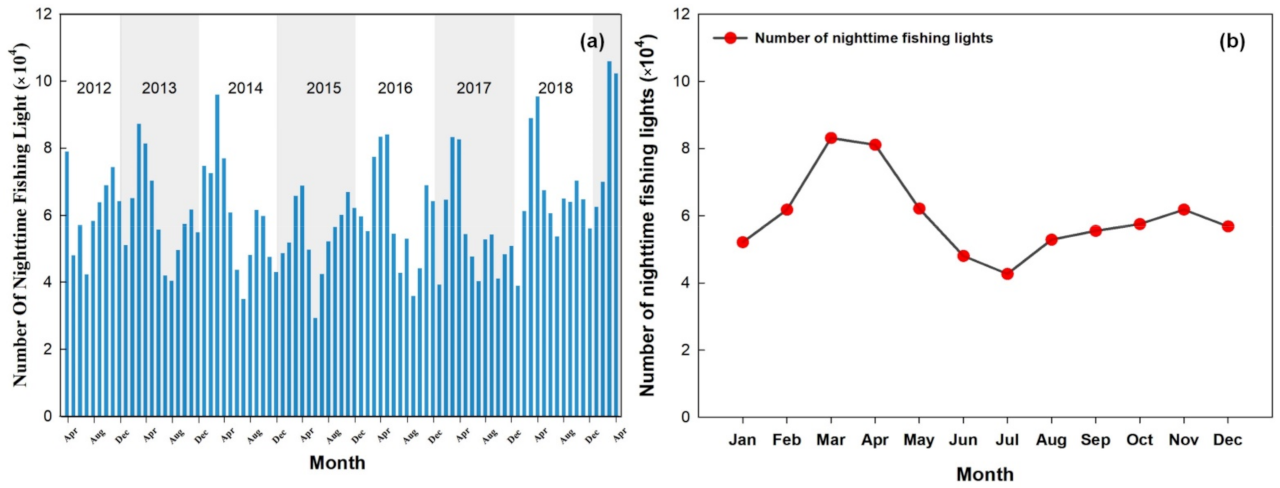
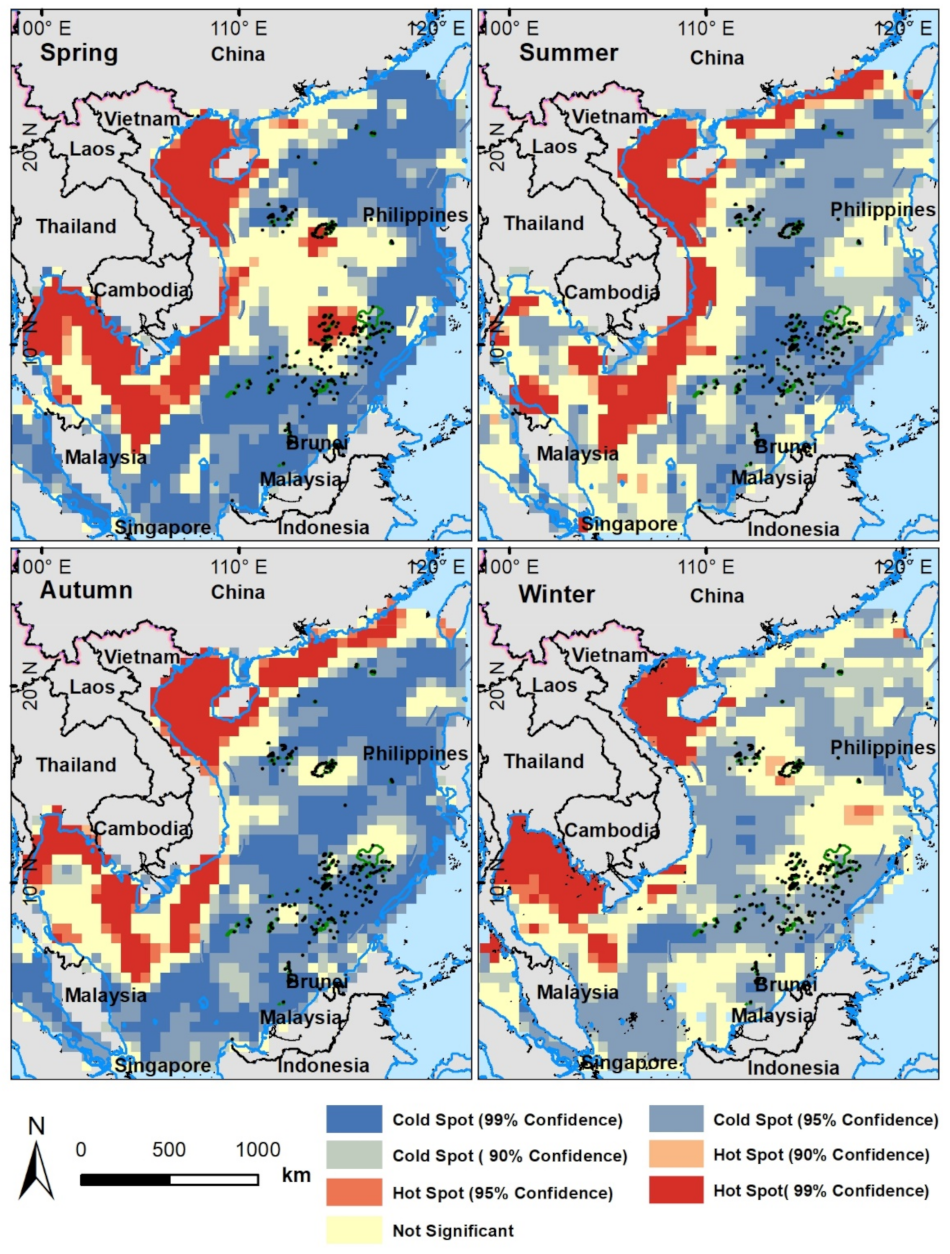

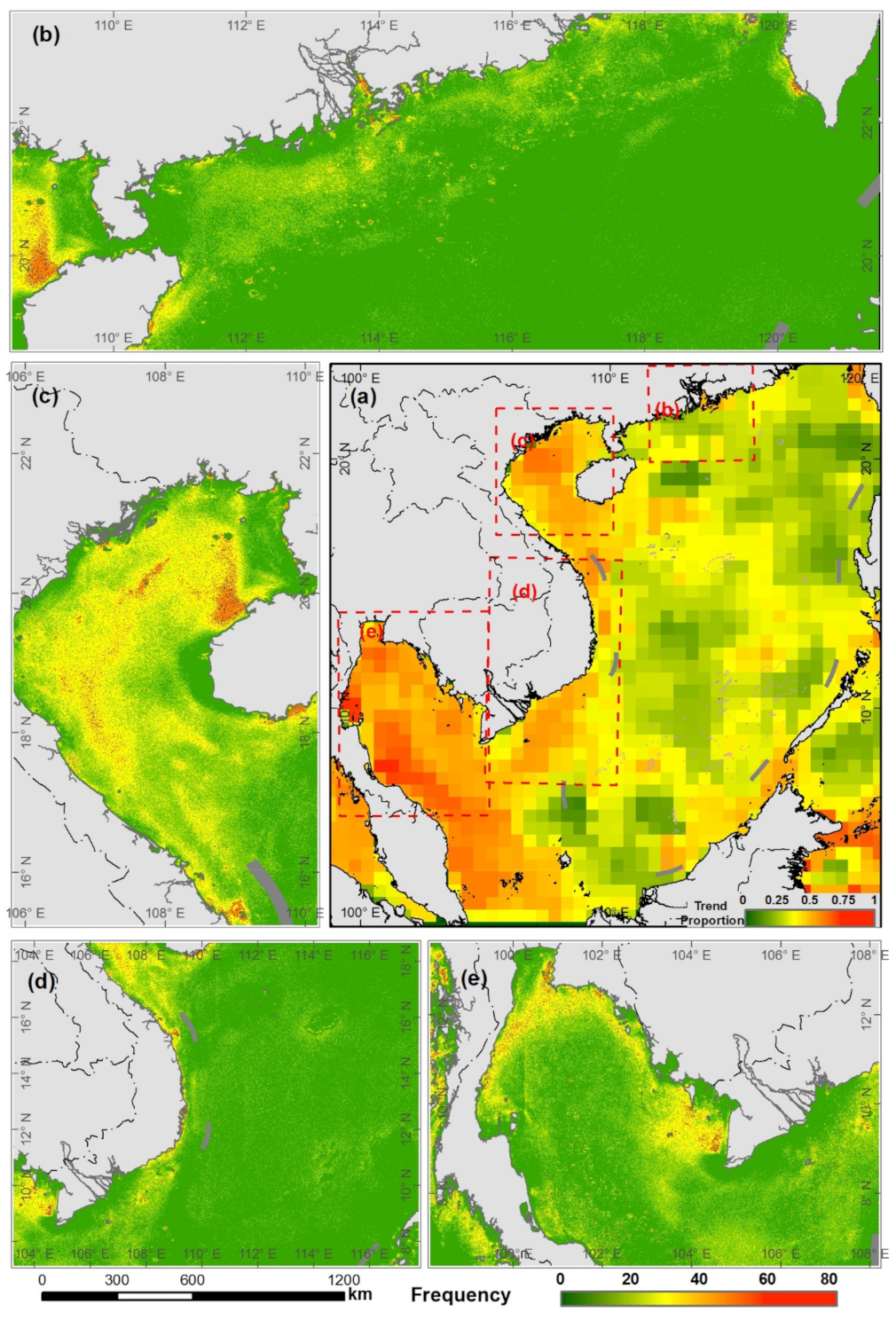
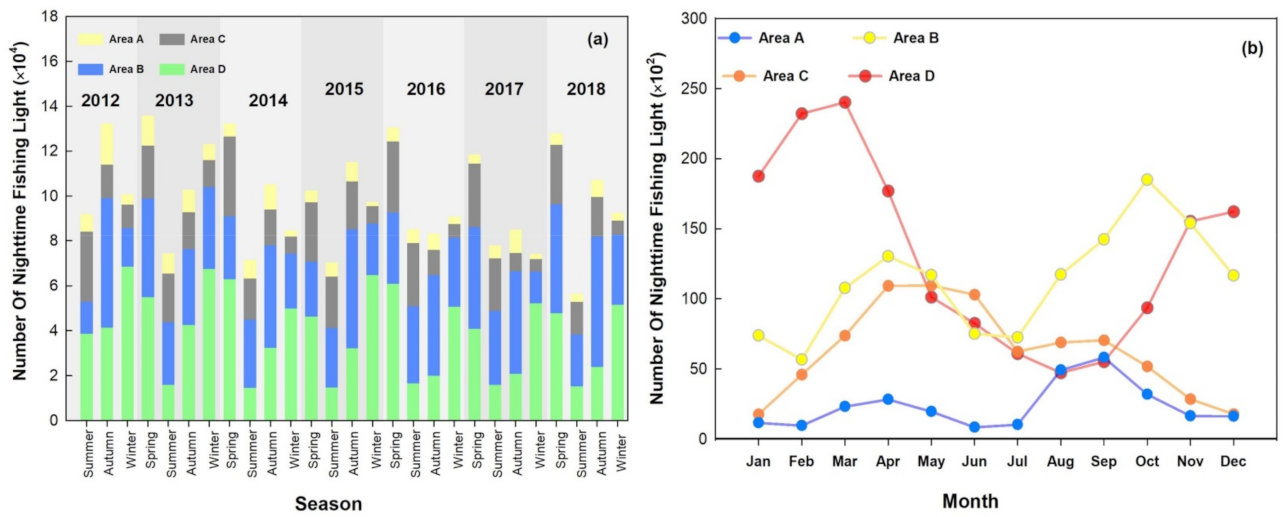


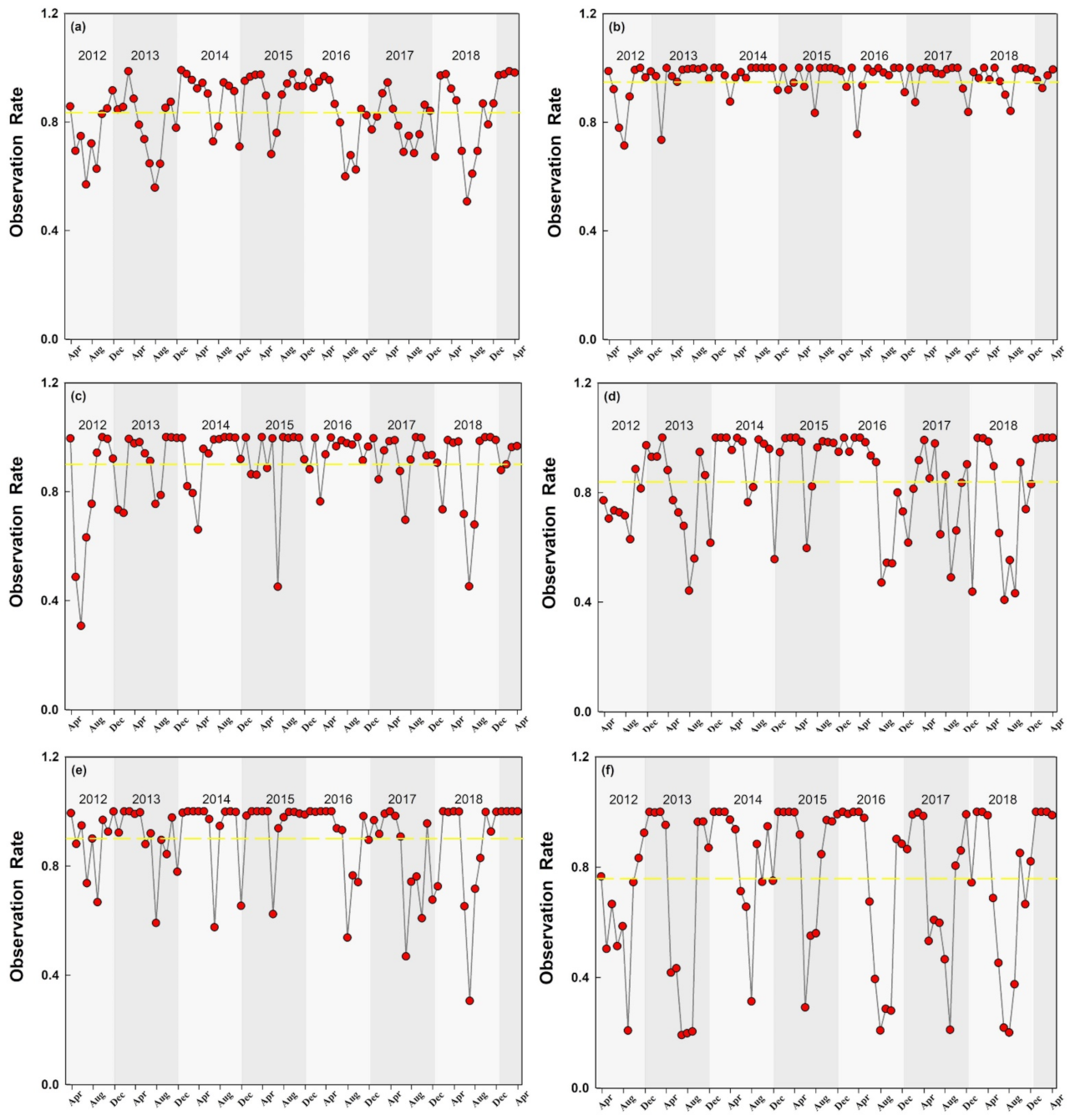

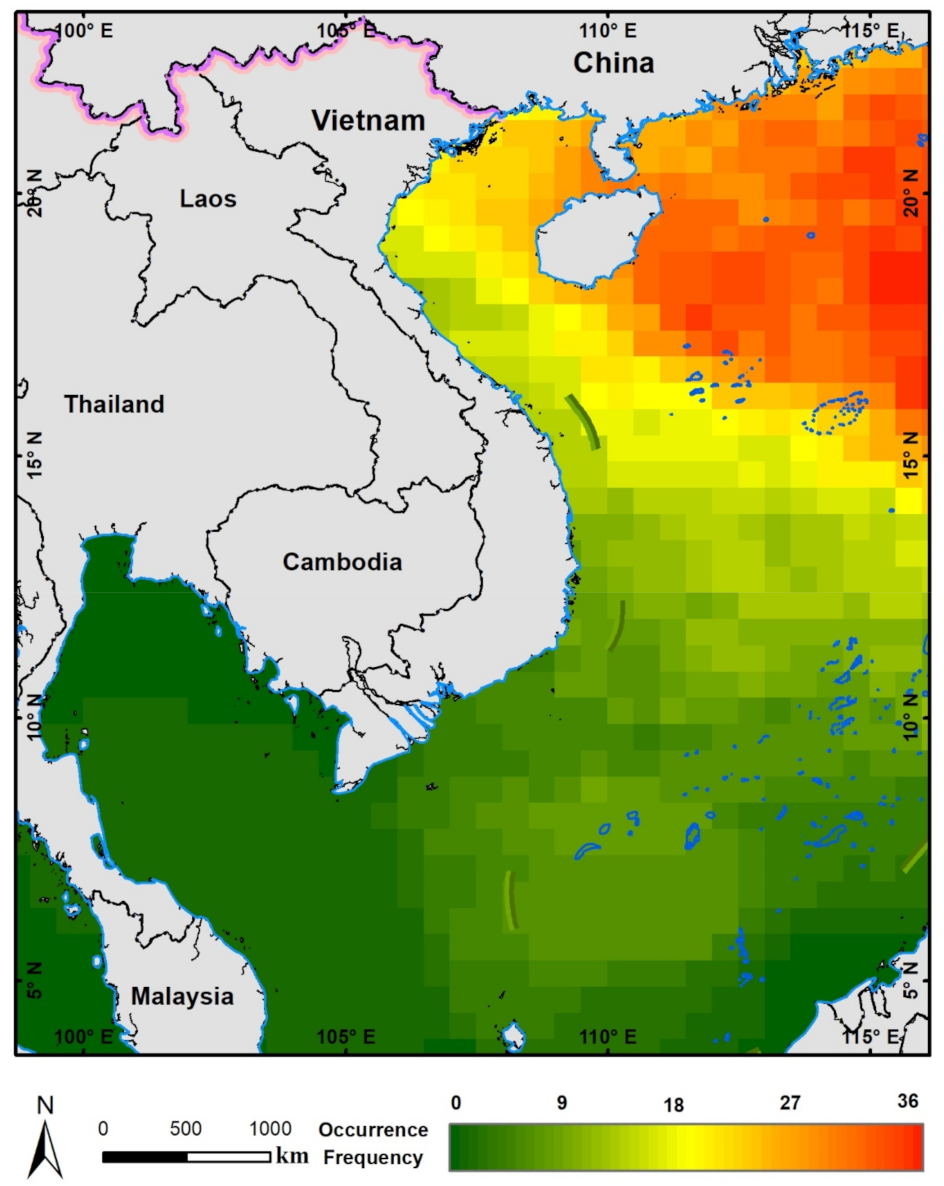
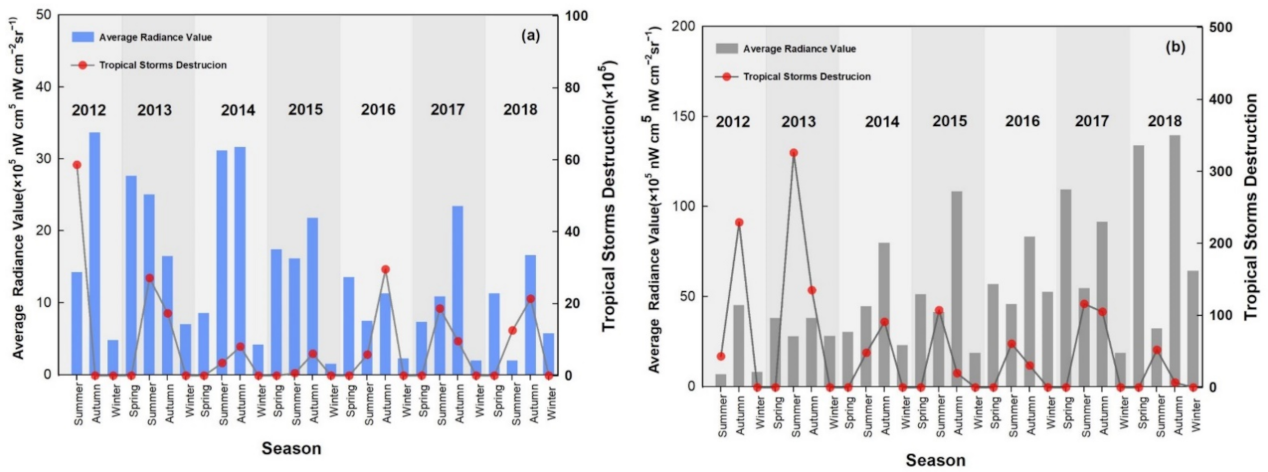
| Hotspots (p < 0.05) | Cold Spots (p < 0.05) | Random Spots | |
|---|---|---|---|
| Spring | 23.3% | 45.7% | 31% |
| Summer | 23% | 37% | 40% |
| Autumn | 21.3% | 51.5% | 27.2% |
| Winter | 17.6% | 35.2% | 47.2% |
Publisher’s Note: MDPI stays neutral with regard to jurisdictional claims in published maps and institutional affiliations. |
© 2021 by the authors. Licensee MDPI, Basel, Switzerland. This article is an open access article distributed under the terms and conditions of the Creative Commons Attribution (CC BY) license (https://creativecommons.org/licenses/by/4.0/).
Share and Cite
Li, H.; Liu, Y.; Sun, C.; Dong, Y.; Zhang, S. Satellite Observation of the Marine Light-Fishing and Its Dynamics in the South China Sea. J. Mar. Sci. Eng. 2021, 9, 1394. https://doi.org/10.3390/jmse9121394
Li H, Liu Y, Sun C, Dong Y, Zhang S. Satellite Observation of the Marine Light-Fishing and Its Dynamics in the South China Sea. Journal of Marine Science and Engineering. 2021; 9(12):1394. https://doi.org/10.3390/jmse9121394
Chicago/Turabian StyleLi, Huiting, Yongxue Liu, Chao Sun, Yanzhu Dong, and Siyu Zhang. 2021. "Satellite Observation of the Marine Light-Fishing and Its Dynamics in the South China Sea" Journal of Marine Science and Engineering 9, no. 12: 1394. https://doi.org/10.3390/jmse9121394
APA StyleLi, H., Liu, Y., Sun, C., Dong, Y., & Zhang, S. (2021). Satellite Observation of the Marine Light-Fishing and Its Dynamics in the South China Sea. Journal of Marine Science and Engineering, 9(12), 1394. https://doi.org/10.3390/jmse9121394






